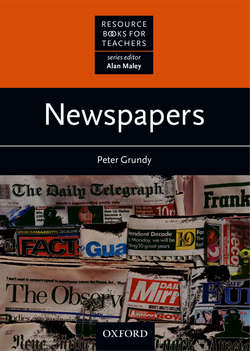Newspapers

Реклама. ООО «ЛитРес», ИНН: 7719571260.
Оглавление
Peter Grundy. Newspapers
Acknowledgements
The author and series editor
Foreword
Introduction
How to use this book
1 Working creatively with newspapers
Newspapers in coursebooks
Newspapers and English for Specific Purposes
Newspaper materials resource books
Working with newspapers
Imaginative newspaper work
Material requirements and conditions for creative work
2 Building confidence and familiarity
2.1 When I hit the headlines
2.2 The letter I never wrote (until now)
2.3 What’s in a newspaper
2.4 New names
2.5 Names in the news
2.6 Understanding what we don’t understand
2.7 Hide and seek
2.8 Where to find it
2.9 Where to put it
2.10 Front pages
2.11 Reading for leisure/reading for work
2.12 Questions and advice
2.13 Things I want to know
2.14 Probing human interest stories
2.15 Which story next?
2.16 Categorizing stories
2.17 Picture into story
2.18 Culture and newspapers
2.19 News stories in two cultures
2.20 I expected to find … and I was surprised
2.21 Headline and story
2.22 Newsvendors’ posters
2.23 Three pairing techniques
2.24 Story chains
2.25 The panel
2.26 Matching comment and newspaper
2.27 The stories I would like to read
2.28 Reviews
2.29 Buying newspapers
2.30 Reading your own paper
3 Working with texts
3.1 Matching story and summary
3.2 Same name, no relative
3.3 The short, short story
3.4 Separating news and comment
3.5 Why the headline?
3.6 Which writer?
3.7 How original is the language?
3.8 Grading for difficulty
3.9 Finding stories
3.10 Enough is enough
3.11 Rejects
3.12 Same theme, different treatments
3.13 Reconstructing stories
3.14 Identical and fraternal twins
3.15 One story, many versions
3.16 Stories and headlines 1
3.17 Stories and headlines 2
3.18 Exaggeration and inaccuracy
3.19 Fleshing stories out
3.20 Skeleton stories
3.21 Completing a story
3.22 Combining stories
4 Working with pictures
4.1 What is a picture?
4.2 Picture categories
4.3 Mood pictures
4.4 Appropriate pictures
4.5 Picture visualization
4.6 Finding stories for pictures
4.7 Finding pictures for stories
4.8 Matching pictures and stories
4.9 Predicting headlines and stories
4.1 °Captions
4.11 Best picture, story, and headline
4.12 Picture awards
4.13 My picture
4.14 My picture and my story
4.15 The good, the bad, and the ugly
5 Project work
5.1 From news to news story
5.2 Being a journalist
5.3 Readers’ competitions
5.4 Radio reviews
5.5 Papers from the past
5.6 Surveys
5.7 Topics in the news
5.8 Class newspapers
5.9 Collages
5.10 Awards
5.11 Will it run?
5.12 People in the news
5.13 Winners and losers
5.14 The picture gallery
6 Personal responses
6.1 Your headlines, my stories
6.2 What’s happening to people like me?
6.3 Which do you choose?
6.4 A present from the Press
6.5 A collage for a friend
6.6 I chose this story because …
6.7 That’s nearly me
6.8 Who would I be?
6.9 Someone I’d change places with – well, nearly
6.10 Sharing a chosen story
6.11 Classifying stories
6.12 Categories of story
6.13 A story I associate with
6.14 A story I relate to
6.15 Reacting
6.16 Brainstorming responses
6.17 Was it worth reading?
6.18 Yuk
6.19 Affective language
Appendix
Bibliography
Titles in the Resource Books for Teachers series
Отрывок из книги
Peter Grundy has taught in schools in Britain and Germany, and has worked in higher education as a teacher trainer. From 1979 to 2002 he was a lecturer at the University of Durham, where he taught pragmatics and applied linguistics to undergraduates and MA courses in ELT. He spent 1994–6 on leave from Durham in Hong Kong where he taught EAP and language teaching methodology at The Hong Kong Polytechnic University. He is currently Associate Principal Lecturer at Northumbria University. He has taught on many summer schools and specialist courses in the UK and overseas stretching back over nearly thirty years. He is author of Writing for Study Purposes (with Arthur Brookes), Language through Literature (with Susan Bassnett), Beginners (in this series), and Doing Pragmatics.
Alan Maley worked for The British Council from 1962 to 1988, serving as English Language Officer in Yugoslavia, Ghana, Italy, France, and China, and as Regional Representative in South India (Madras). From 1988 to 1993 he was Director-General of the Bell Educational Trust, Cambridge. From 1993 to 1998 he was Senior Fellow in the Department of English Language and Literature of the National University of Singapore. He is currently a freelance consultant and Director of the graduate English programme at Assumption University, Bangkok. He has written Literature, in this series (with Alan Duff, OUP 1990), Beyond Words, Sounds Interesting, Sounds Intriguing, Words, Variations on a Theme, and Drama Techniques in Language Learning (all with Alan Duff), The Mind’s Eye (with Françoise Grellet and Alan Duff), and Learning to Listen and Poem into Poem (with Sandra Moulding).
.....
This book, while not neglecting any of these areas, concentrates on developing an authentic response from the learners. The activities are aimed at helping learners to read newspapers as newspapers, and to react to them as real people. (See especially Chapter 6, ‘Personal responses’.) All too often the newspaper article has been treated as an object for linguistic or cultural dissection and analysis. Such practices can lead to the teacher continuing to squeeze the text dry long after the sap of genuine interest has been savoured by the learners.
One of the major problems in incorporating newspaper material in books is loss of topicality. An ephemeral medium is frozen into a kind of permanence, and is rapidly perceived as dated. This book has relatively few re-printed articles. Instead it offers a very wide range of highly creative and original activities which could be applied to almost any article or extract. In this way, it provides teachers with a valuable resource for using the articles of their own choice.
.....